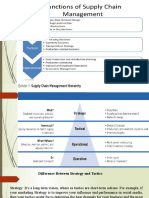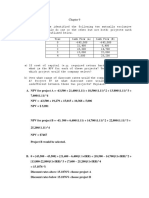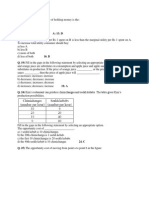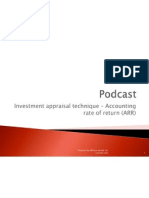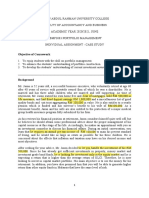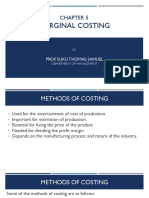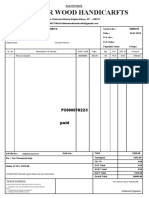The Basics of Capital Budgeting: Should We Build This Plant?
The Basics of Capital Budgeting: Should We Build This Plant?
Uploaded by
Angga BayuCopyright:
Available Formats
The Basics of Capital Budgeting: Should We Build This Plant?
The Basics of Capital Budgeting: Should We Build This Plant?
Uploaded by
Angga BayuOriginal Title
Copyright
Available Formats
Share this document
Did you find this document useful?
Is this content inappropriate?
Copyright:
Available Formats
The Basics of Capital Budgeting: Should We Build This Plant?
The Basics of Capital Budgeting: Should We Build This Plant?
Uploaded by
Angga BayuCopyright:
Available Formats
12 - 1
CHAPTER 12
The Basics of Capital Budgeting
Should we build this plant?
12 - 2
What is capital budgeting? Analysis of potential additions to fixed assets.
Long-term decisions; involve large expenditures.
Very important to firms future.
12 - 3
Capital Budgeting Decision Rules
5 keys methods to rank project
Payback Discounted Payback Accounting Rate of Return Net Present Value (NPV)
Internal Rate of Return (IRR)
Modified Internal Rate of Return (MIRR)
12 - 4
Steps 1. Estimate CFs (inflows & outflows). 2. Assess riskiness of CFs.
3. Determine k = WACC (adj.).
4. Find NPV and/or IRR.
5. Accept if NPV > 0 and/or IRR > WACC.
12 - 5
What is the difference between independent and mutually exclusive projects? Projects are: independent, if the cash flows of one are unaffected by the acceptance of the other. mutually exclusive, if the cash flows of one can be adversely impacted by the acceptance of the other.
12 - 6
An Example of Mutually Exclusive Projects
BRIDGE vs. BOAT to get products across a river.
12 - 7
Normal Cash Flow Project: Cost (negative CF) followed by a series of positive cash inflows. One change of signs. Nonnormal Cash Flow Project: Two or more changes of signs. Most common: Cost (negative CF), then string of positive CFs, then cost to close project. Nuclear power plant, strip mine.
12 - 8
Inflow (+) or Outflow (-) in Year 0 1 + 2 + 3 + 4 + 5 + N N NN
+
-
+
-
+
+
+
+
+ N
NN N
NN
+
-
+
+
+
+
12 - 9
What is the payback period?
- The number of years required to recover a projects cost, - or how long does it take to get our money back?
Payback = Year before full recovery + the last unrecovered cost Cash flow during year
12 - 10
Example: Allied Components Company Projects net cash flows ($000), Allied Projects WACC = 10%
Year Project L Project S
0
1 2 3
(100)
10 60 80
(100)
70 50 20
12 - 11
Payback for Project L (Long: Large CFs in later years)
0 CFt -100 Cumulative -100 PaybackL = 2 + 1 10 -90 30/80 2
2.4
3 80 50
60 100 -30 0
= 2.375 years
12 - 12
Project S (Short: CFs come quickly)
0
CFt -100
1.6 2
3
20 40
70 100 50 -30 0 20
Cumulative -100
Paybacks
= 1 + 30/50 = 1.6 years
12 - 13
Strengths of Payback: 1. Provides an indication of a projects risk and liquidity. 2. Easy to calculate and understand.
Weaknesses of Payback:
1. Ignores the TVM. 2. Ignores CFs occurring after the payback period.
12 - 14
Discounted Payback: Uses discounted for project L rather than raw CFs.
0 CFt PVCFt -100 -100
10%
1 10 9.09 -90.91
2 60 49.59 -41.32
3 80 60.11 18.79
Cumulative -100
Discounted = 2 payback
+ 41.32/60.11 = 2.7 years
Recover invest. + cap. costs in 2.7 years.
12 - 15
Accounting Rate of Return (ARR)
ARR = Average Annual Income Average Investment
Average Annual Income = Average Cash Flow Average depreciation Average Investment = (Cost + Salvage Value)/2
12 - 16
Accounting Rate of Return (ARR)
Average Annual Income (AAI) L: Average cash flow L: 150/3 = 50 Average depreciation: 100/3 = 33.3 AAI L: 50 33.3 = 16.7 Average Investment L: (Cost + Salvage Value)/2: (100+0)/2 = 50 ARR L = 16.7/50 33.4% ARR S = 13.4/50 26.8%
12 - 17
NPV: Sum of the PVs of inflows and outflows.
CFt NPV t . t 0 1 k
n
12 - 18
Whats Project Ls NPV? Project L: 0 -100.00 9.09 49.59 60.11 18.79 = NPVL 10% 1 10 2 60 3 80
12 - 19
Calculator Solution Enter in CF for L: -100 10 60 CF0 CF1
CF2
CF3
80
10
i%
RCL NPV
= 18.78 = NPVL
NPVS = $19.98.
12 - 20
Rationale for the NPV Method NPV = PV inflows Cost = Net gain in wealth. Accept project if NPV > 0.
Choose between mutually exclusive projects on basis of higher NPV. Adds most value.
12 - 21
Using NPV method, which project(s) should be accepted?
If Projects S and L are mutually exclusive, accept S because NPVs > NPVL . If S & L are independent, accept both; NPV > 0.
12 - 22
Internal Rate of Return: IRR
0 CF0 Cost 1 CF1 2 CF2 Inflows 3 CF3
IRR is the discount rate that forces PV inflows = cost. This is the same as forcing NPV = 0.
12 - 23
NPV: Enter k, solve for NPV.
CFt 1 k t NPV. t 0
n
IRR: Enter NPV = 0, solve for IRR.
CFt 1 IRR t 0. t 0
n
12 - 24
Whats Project Ls IRR?
0
IRR = ?
1 10
2 60
3 80
-100.00 PV1 PV2 PV3
0 = NPV
Enter CFj in CF, then press IRR: IRRL = 18.13%. IRRS = 23.56%.
12 - 25
Find IRR if CFs are constant:
0
-100
INPUTS 3
N COMP i% IRR = ?
1
40
2
40
-100
PV
3
40
40
PMT
0
FV
OUTPUT
9.70%
Or, with CF, enter CFj and press IRR = 9.70%.
12 - 26
Q.
A.
How is a projects IRR related to a bonds YTM? They are the same thing. A bonds YTM is the IRR if you invest in the bond.
1
IRR = ?
10
...
90 90 1090
-1134.2
IRR = 7.08%
12 - 27
Rationale for the IRR Method
If IRR > WACC, then the projects rate of return is greater than its cost--some return is left over to boost stockholders returns. Example: WACC = 10%, IRR = 15%. Profitable.
12 - 28
IRR Acceptance Criteria
If IRR > k, accept project.
If IRR < k, reject project.
12 - 29
Decisions on Projects S and L per IRR
If S and L are independent, accept both. IRRs > k = 10%.
If S and L are mutually exclusive, accept S because IRRS > IRRL .
12 - 30
Construct NPV Profiles
Enter CFs in CFLO and find NPVL and NPVS at different discount rates:
k 0 5 10 15 20 NPVL 50 33 19 7 (4 (4) NPVS 40 29 20 12 5
12 - 31
NPV ($)
60
. 40 .
50 30 20 10
. .
Crossover Point = 8.7%
k 0 5 10 15 20
NPVL 50 33 19 7 (4)
NPVS 40 29 20 12 5
.
L
5 10
. .
15
0
-10
. . 20
IRRS = 23.6%
.
23.6
Discount Rate (%)
IRRL = 18.1%
12 - 32
NPV and IRR always lead to the same accept/reject decision for independent projects:
NPV ($)
IRR > k and NPV > 0 Accept.
k > IRR and NPV < 0. Reject.
k (%) IRR
12 - 33
Mutually Exclusive Projects
NPV
L
k < 8.7: NPVL> NPVS , IRRS > IRRL CONFLICT k > 8.7: NPVS> NPVL , IRRS > IRRL NO CONFLICT
IRRS
8.7
%
IRRL
12 - 34
To Find the Crossover Rate 1. Find cash flow differences between the projects. See data at beginning of the case. 2. Enter these differences in CFLO register, then press IRR. Crossover rate = 8.68%, rounded to 8.7%. 3. Can subtract S from L or vice versa, but better to have first CF negative. 4. If profiles dont cross, one project dominates the other.
12 - 35
To Find the Crossover Rate
Year 0 1 2 3 Project L (100) 10 60 80 Project S (100) 70 50 20 L-S 0 -60 10 60 8.68%
Cross
over
12 - 36
Two Reasons NPV Profiles Cross 1. Size (scale) differences. Smaller project frees up funds at t = 0 for investment. The higher the opportunity cost, the more valuable these funds, so high k favors small projects. 2. Timing differences. Project with faster payback provides more CF in early years for reinvestment. If k is high, early CF especially good, NPVS > NPVL.
12 - 37
Reinvestment Rate Assumptions NPV assumes reinvest at k (opportunity cost of capital). IRR assumes reinvest at IRR. Reinvest at opportunity cost, k, is more realistic, so NPV method is best. NPV should be used to choose between mutually exclusive projects.
12 - 38
Managers like rates--prefer IRR to NPV comparisons. Can we give them a better IRR?
Yes, MIRR is the discount rate that causes the PV of a projects terminal value (TV) to equal the PV of costs. TV is found by compounding inflows at WACC.
Thus, MIRR assumes cash inflows are reinvested at WACC.
12 - 39
MIRR for Project L (k = 10%)
0
10%
1 10.0
10%
2 60.0
10%
3 80.0
-100.0
66.0 12.1 158.1
TV inflows
-100.0 0 = PV outflows
MIRR = 16.5%
$158.1 $-100 (1 + MIRRL)3 MIRRL = 16.5%
12 - 40
To find TV with Casio, enter in CFLO: CF0 = 0, CF1 = 10, CF2 = 60, CF3 = 80 = 10 i% RCL NPV = 118.78 = PV of inflows.
Enter PV = -118.78, n = 3, i% = 10, PMT = 0. Press COMP FV = 158.10 = FV of inflows. Enter FV = 158.10, PV = -100, PMT = 0, n = 3. Press COMP i% = 16.50% = MIRR.
12 - 41
Why use MIRR versus IRR?
MIRR correctly assumes reinvestment at opportunity cost = WACC. MIRR also avoids the problem of multiple IRRs.
Managers like rate of return comparisons, and MIRR is better for this than IRR.
You might also like
- HSE Policy Statement A4 ENGLISH WebDocument1 pageHSE Policy Statement A4 ENGLISH WebHunter100% (1)
- Supply Chain of Automotive Industry V/S Suplly Chain of FMCG IndustryDocument9 pagesSupply Chain of Automotive Industry V/S Suplly Chain of FMCG IndustryMuhammad Umar KhanNo ratings yet
- Introduction of Strategic Supply Chain ManagementDocument50 pagesIntroduction of Strategic Supply Chain ManagementMd. Ariful HassanNo ratings yet
- Corporate Finance NPV and IRR SolutionsDocument3 pagesCorporate Finance NPV and IRR SolutionsMark HarveyNo ratings yet
- Test Bank 3 - Ia 3Document25 pagesTest Bank 3 - Ia 3Xiena67% (3)
- Chapter 11 Capital Budgeting SolutionsDocument10 pagesChapter 11 Capital Budgeting SolutionssaniyahNo ratings yet
- AbgenixDocument5 pagesAbgenixKESHAV NARAYANNo ratings yet
- Linear ProgrammingDocument15 pagesLinear ProgrammingMoid Aretaño MesaNo ratings yet
- CIMA E1 - OM - Chapter - 6Document50 pagesCIMA E1 - OM - Chapter - 6MichelaRosignoliNo ratings yet
- MCQs Business EconomicsDocument2 pagesMCQs Business EconomicsKhalid WaheedNo ratings yet
- Module 4 Replacement PolicyDocument33 pagesModule 4 Replacement PolicyAnushka ChokseNo ratings yet
- Managerial Economics 02Document35 pagesManagerial Economics 02shihab285No ratings yet
- A Review of The State Pension Scheme in Ghana PDFDocument59 pagesA Review of The State Pension Scheme in Ghana PDFTAKUNDANo ratings yet
- Time Value of MoneyDocument60 pagesTime Value of MoneyJash ChhedaNo ratings yet
- Business Pitching PaperDocument16 pagesBusiness Pitching Papercublion121No ratings yet
- Capital Budgeting Techniques PDFDocument57 pagesCapital Budgeting Techniques PDFMecheal ThomasNo ratings yet
- ch13Document60 pagesch13Ains M. BantuasNo ratings yet
- Formulation of LP Problems-130928022247-Phpapp02Document13 pagesFormulation of LP Problems-130928022247-Phpapp02Anish MonachanNo ratings yet
- TranshipmentDocument12 pagesTranshipmentSachin YadavNo ratings yet
- Chapter 1Document14 pagesChapter 1joelNo ratings yet
- Discounted Cash Flow Valuation Section Worksheet-2Document7 pagesDiscounted Cash Flow Valuation Section Worksheet-2Yehia ElmasryNo ratings yet
- 4a. Capital BudgetingDocument6 pages4a. Capital BudgetingShubhrant ShuklaNo ratings yet
- QueuingDocument45 pagesQueuinglamartinezmNo ratings yet
- Ca02ca3103 RMTLPP - Simplex MethodDocument42 pagesCa02ca3103 RMTLPP - Simplex MethodHimanshu KumarNo ratings yet
- Assignment of Time Value of MoneyDocument3 pagesAssignment of Time Value of MoneyMuxammil IqbalNo ratings yet
- Financial Management: Operating Leverage & Financial LeverageDocument70 pagesFinancial Management: Operating Leverage & Financial LeverageHarnitNo ratings yet
- Cost Volume Profit AnalysisDocument20 pagesCost Volume Profit AnalysisSidharth RayNo ratings yet
- Chapter 3 Linear ProgrammingDocument35 pagesChapter 3 Linear ProgrammingSaad ShaikhNo ratings yet
- Practice Questions On Time Value of MoneyDocument7 pagesPractice Questions On Time Value of MoneyShashank shekhar ShuklaNo ratings yet
- Variable Costs Vs Fixed CostsDocument1 pageVariable Costs Vs Fixed CostsClaire MacaraegNo ratings yet
- Project Appraisal and Selection: Time Preference For MoneyDocument16 pagesProject Appraisal and Selection: Time Preference For MoneynathnaelNo ratings yet
- Estimating IRR With Fake Payback Period-L10Document9 pagesEstimating IRR With Fake Payback Period-L10akshit_vij0% (1)
- Capital Investment and Appraisal MethodsDocument34 pagesCapital Investment and Appraisal MethodsAnesu ChimhowaNo ratings yet
- Product Design and Process SelectionDocument25 pagesProduct Design and Process Selectionira_mishra_3No ratings yet
- Operations Management - Process Design SampleDocument2 pagesOperations Management - Process Design SampleArun ThevarNo ratings yet
- Sensitivity AnalysisDocument4 pagesSensitivity AnalysisBijoy SalahuddinNo ratings yet
- Fixed VS Variable CostsDocument5 pagesFixed VS Variable Costssonia100% (1)
- Ecf630-Final Examination - May 2021Document12 pagesEcf630-Final Examination - May 2021Kalimanshi NsakazaNo ratings yet
- Accounting Rate of ReturnDocument16 pagesAccounting Rate of Returnshanky631100% (1)
- Chapter 1 Introduction To Quantitative AnalysisDocument35 pagesChapter 1 Introduction To Quantitative AnalysisIzwan YusofNo ratings yet
- Internal Rate of ReturnDocument6 pagesInternal Rate of ReturnDagnachew Amare DagnachewNo ratings yet
- 08rr410301 Operations ResearchDocument12 pages08rr410301 Operations ResearchandhracollegesNo ratings yet
- Claasification of CostsDocument21 pagesClaasification of CostsSaima Nazir KhanNo ratings yet
- 5 - Marginal CostingDocument9 pages5 - Marginal Costing9897856218No ratings yet
- Capital Budgeting MathsDocument2 pagesCapital Budgeting MathsAli Akand Asif67% (3)
- Dividend Policy - Traditional PositionDocument7 pagesDividend Policy - Traditional PositionVaidyanathan Ravichandran67% (3)
- Module 4 - Business ForecastingDocument67 pagesModule 4 - Business Forecastingnkrumah princeNo ratings yet
- 2 - Tutorial 1 - Facility LocationDocument4 pages2 - Tutorial 1 - Facility LocationRami Abdelaal100% (1)
- BIM Model Management PDFDocument6 pagesBIM Model Management PDFpyaephyozawNo ratings yet
- Case Study (Portfolio)Document6 pagesCase Study (Portfolio)WinniferTeohNo ratings yet
- Cost Accounting Quiz AnswersDocument2 pagesCost Accounting Quiz AnswersGlessey Mae Baito LuvidicaNo ratings yet
- Simplex MethodDocument114 pagesSimplex MethodDaniel NimabwayaNo ratings yet
- Cost of Equity: Meaning and MethodsDocument14 pagesCost of Equity: Meaning and MethodsTejas PatelNo ratings yet
- Basic STD CostingDocument5 pagesBasic STD CostingSajidZiaNo ratings yet
- Descriptive Ethical TheoriesDocument27 pagesDescriptive Ethical TheoriesBETHMI MITHARA JAYAWARDENANo ratings yet
- 05 - Hedging, Speculation & Arbitrage With Index FuturesDocument54 pages05 - Hedging, Speculation & Arbitrage With Index FuturesnaseeemNo ratings yet
- Chapter 5 Marginal CostingDocument36 pagesChapter 5 Marginal CostingSuku Thomas SamuelNo ratings yet
- 3 Inventory Management and Risk PoolingDocument60 pages3 Inventory Management and Risk PoolingpranavsharadNo ratings yet
- Economic Order Quantity (EOQ) - Practical Problems and SolutionsDocument18 pagesEconomic Order Quantity (EOQ) - Practical Problems and SolutionsahmedNo ratings yet
- ABC Sample ProblemsDocument16 pagesABC Sample ProblemsrsalicsicNo ratings yet
- Ch5 Summary and Exercises Student v3Document41 pagesCh5 Summary and Exercises Student v3Ahmet AydemirNo ratings yet
- PPT2 - W1-S2 - Simplex Method & Duality Theory-R0Document73 pagesPPT2 - W1-S2 - Simplex Method & Duality Theory-R0Haris Purna WidyatamaNo ratings yet
- MARKOWITZ Portfolio TheoryDocument32 pagesMARKOWITZ Portfolio TheoryDicky IrawanNo ratings yet
- Problems On Process CostingDocument8 pagesProblems On Process CostingMadire AnushaNo ratings yet
- The Basics of Capital Budgeting: Should We Build This Plant?Document28 pagesThe Basics of Capital Budgeting: Should We Build This Plant?Jessica Adharana KurniaNo ratings yet
- Sample Question Paper CFPDocument9 pagesSample Question Paper CFPSreenath HtaneersNo ratings yet
- Analysis of Agency Problems in Dhaka Stock Exchange-Listed CompaniesDocument28 pagesAnalysis of Agency Problems in Dhaka Stock Exchange-Listed Companiesghost2347007No ratings yet
- The Coca Cola Exports v. CIR, CTA Case No. 5238, Dec. 19, 1997Document6 pagesThe Coca Cola Exports v. CIR, CTA Case No. 5238, Dec. 19, 1997SGNo ratings yet
- Berger Paints India Limited: Rationale and Key Rating DriversDocument6 pagesBerger Paints India Limited: Rationale and Key Rating DriversHemant ChaudhariNo ratings yet
- MGT 101 Final Term Solved Papers by Cyber DevilDocument10 pagesMGT 101 Final Term Solved Papers by Cyber DevilTayyab RasheedNo ratings yet
- Drake CV - 2017 - 09 - 26Document4 pagesDrake CV - 2017 - 09 - 26Thu NguyenNo ratings yet
- Fakhr Wood Handicarfts: 7 PO0000 Paid 8223Document2 pagesFakhr Wood Handicarfts: 7 PO0000 Paid 8223Sunil PatelNo ratings yet
- What Is The Difference Between Steady State and Golden Rule Level of Capital?Document2 pagesWhat Is The Difference Between Steady State and Golden Rule Level of Capital?EmaanNo ratings yet
- Nine Building Blocks of The Business ModelDocument3 pagesNine Building Blocks of The Business ModelTobeFrankNo ratings yet
- UPAC PackagingDocument27 pagesUPAC PackagingMelissa CairneyNo ratings yet
- Mba Mba HRM Nirma Admission Brochure 2020Document24 pagesMba Mba HRM Nirma Admission Brochure 2020Vaibhav PrajapatiNo ratings yet
- Business Plan On High Jazz EntDocument21 pagesBusiness Plan On High Jazz Entmauricio ricardoNo ratings yet
- Final Programme NDRM SummitDocument7 pagesFinal Programme NDRM SummitAmor Tan SingcoNo ratings yet
- EA Form SEP 2023Document1 pageEA Form SEP 2023boyssss88No ratings yet
- Chapter 34Document10 pagesChapter 34Kaila Mae Tan DuNo ratings yet
- Human FlourishingDocument22 pagesHuman FlourishingESCOBAR, Ma. Michaela G.- PRESNo ratings yet
- 2020 Yale ReportDocument28 pages2020 Yale ReportDavidd Pascual FernándezcNo ratings yet
- Integrated Approach of Material ManagementDocument14 pagesIntegrated Approach of Material ManagementShashidhar KasturiNo ratings yet
- Amenyo Enterprise SolutionDocument3 pagesAmenyo Enterprise Solutionwiafelawrence03No ratings yet
- Percentage Taxes NotesDocument4 pagesPercentage Taxes NotesWearIt Co.No ratings yet
- Resolution 3 - Opening Bank AcctDocument2 pagesResolution 3 - Opening Bank AcctMariel Anne AlvarezNo ratings yet
- BUY 2.5 BHK: in This Case You ShouldDocument1 pageBUY 2.5 BHK: in This Case You ShouldSudhir ChitlaNo ratings yet
- FINAL - Term 2 Grade 9 Demarcations 2023Document10 pagesFINAL - Term 2 Grade 9 Demarcations 2023Ari VaNo ratings yet
- HRM Assignment - 2 - YogenderDocument3 pagesHRM Assignment - 2 - YogenderharryNo ratings yet
- I. II. Iii. IV. VIDocument34 pagesI. II. Iii. IV. VIGonzalo CurielNo ratings yet


